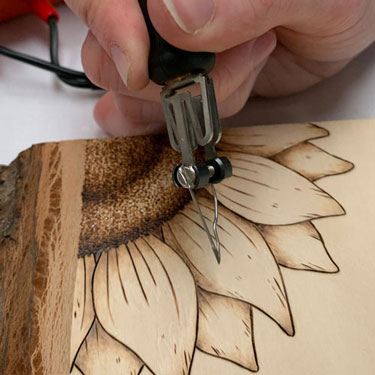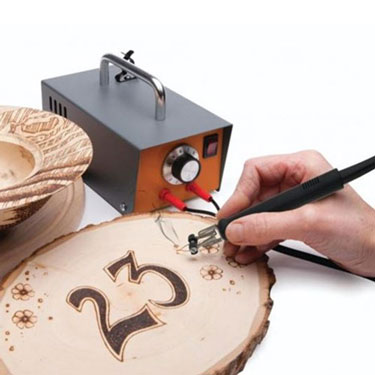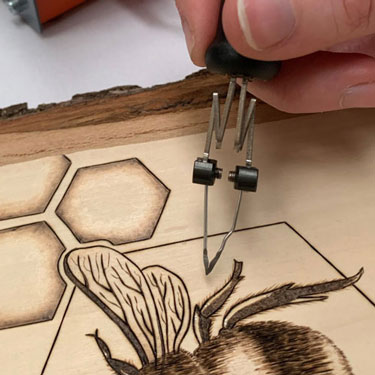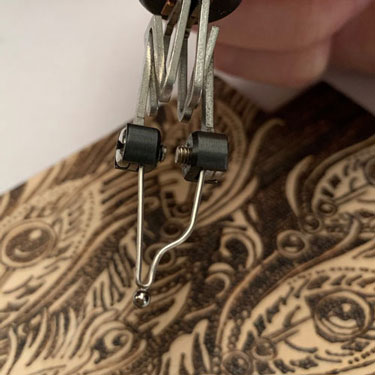Pyrography vs Fractal or ‘Lichtenberg’ Burning
Pyrography is a fast-growing pastime in its own right. For woodworkers it can add a whole new dimension to decorating workpieces. Whether you’re a woodcarver etching lifelike detail to a bird carving or a woodturner creating patterns on your work, pyrography can transform ordinary looking projects into beautifully decorated ornaments, quickly and easily.


And you don’t need to be an artist to create stunningly impressive pieces. The examples above illustrate what can be achieved with nothing more than a little patience.
Pyrography is a safe method of wood burning.
There are universal, yet easily managed, risks attached to burning wood, which include the potential for burns from hot tools, inhaling fumes and the potential associated fire hazard.
Fractal burning is a relatively new technique of creating patterns in timber by applying electrical current from a high-voltage source. Unfortunately, this craft has directly resulted in deaths in Australia and around the world, as it exposes the user to high-voltage electricity.


Pyrography - the art of wood burning with professionally made equipment, is NOT related to Fractal burning and is a safe hobby.
Below are some links with further information on the very real dangers of Fractal Burning:
Oxford Academic Journal of Burn Care & Research - 625 Death Due to Fractal Wood Burning: An Emerging Public Health Problem
Fractal woodburning is associated with devastating high-voltage electrical injuries and death. Prevention efforts should be focused on the potential risks of this art form.
Click here for more information
American Association of Woodturners (AAW) - Fractal burning has killed and could kill you.
The American Association of Woodturners has banned the use of this process at all of its events and has banned articles about use of a fractal burner in all of its publications.
Click here for more information from the American Association of Woodturners (AAW)
National Woodworkers Association (NZ)
The practice of fractal burning is not a minor heath and safety issue – mistakes by the operator or a bystander unaware of the hazards can result in fatalities.
The National Woodworkers Association (NZ) committee has decided to take the same line as the AAW and fractal burning is prohibited from being used at any NAW-related events and activities. The NAW urges member Clubs and Guilds to publicise the dangers of fractal burning and to refrain from demonstrating or featuring the process in their premises (the NAW insurance policy may not cover any adverse consequences resulting from fractal burning). We also strongly suggest that individual clubs running competitions state in their rules that pieces featuring fractal burning are not accepted.
Click here for more information from the National Woodworkers Association (NZ)
Worksafe NZ
Since August 2020 WorkSafe NZ has been notified of two fatal incidents involving the use of high-voltage electricity to create patterns in wood. In both incidents, the person doing the fractal burning was electrocuted.
Click here for more information from Worksafe NZ
WA’s energy safety regulator - Electrical safety warning over deadly wood art device
WA’s energy safety regulator is warning of the potentially fatal dangers of DIY electrical devices after a WA man died while allegedly handling a homemade high-voltage appliance used for wood art.
Click here for more information from WA’s energy safety regulator
ABC News - 'I can't think of anything more dangerous': High-voltage craft work linked to SA death
"The effects on the wood are probably pretty similar to what the effects would be on the human body. It's horrendous," said Mr Jim Corbett from the Office of the Technical Regulator
The regulator said it was concerned amateur wood-workers were learning the practice from online tutorials. There are hundreds of instructional videos on YouTube explaining how to practice wood burning, by modifying household appliances such as microwaves. "We strongly advise people not to do this," Mr Corbett said.
Click here to read the ABC article in full